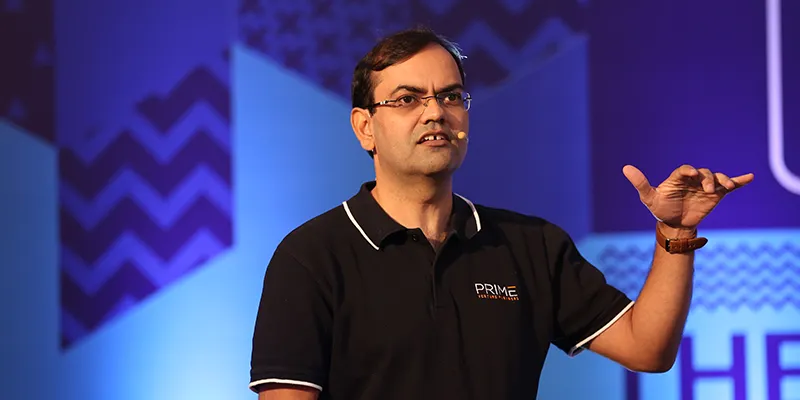5 ways for startups to spot the multiple opportunities in India
At YourStory MobileSparks 2017 in Bengaluru, Amit Somani, Managing Partner at Prime Venture Partners, says that startups need to factor in the reality that Digital India is here to stay.
“Maybe this will be the last MobileSparks, because mobile in India is here to stay. So it will be something else,” began Amit Somani, Managing Partner, Prime Venture Partners.
That got our attention.
Grabbing the first session after lunch is always a challenge, but Amit rather succinctly - as an investor and a speaker - illustrated the key ways in which startups can find great startup opportunities in India.
India, Amit said, has a two-faced infrastructure.

Digital India is here to stay
“While we are lagging in terms of poor roads, intermittent power and haphazard urban planning, we are also leap frogging as one of the fastest growing smartphone markets, having the largest number of open internet users and owing a universal digital platform like Aadhaar and India Stack,” he said.
With over 1.2 billion Aadhaar users, which has enabled easy e-KYC and growth of fintech platforms, Digital India is here to stay. Amit illustrated this with a stack of numbers - over 300 million monthly active users, over 1.5 billion apps being downloaded, and data usage of 200 million and 100 million for YouTube and HotStar respectively.
“Close to 10 years ago when I came back to India, the Gmail web app wouldn't load easily on the browser. Today, mostly thanks to Jio, people on an average are watching videos for two hours,” Amit said. He also referred to growing monetisation.
Citing the example of Google Play, Amit explains that monetisation on Google Play in six months has gone up by 300 percent, thanks to micro-payment options.
“Digital India is clearly here to stay, so what are the key ways in which startups can find opportunities,” Amit asked. He listed down five answers to the interested audience:
Solve basic problems, fast
Quoting Evan Williams, former Chairman and CEO, Twitter, Amit said: “If you study what the really big things on the internet are, you realise they are masters at making things fast and not making people think.” He explained that it is important to look at problems in the market and build products to solve those problems fast.
Taking Maslow’s Hierarchy Needs, Amit Somani listed out Maslow’s Hierarchy of Startups:
- Physiological need of food and shelter. These startups are solving basic needs and are solving it without the hassle of a physical infrastructure; They include the likes of food apps like Swiggy, other grocery apps like BigBasket, or apps like Airbnb. “These solve the basic- roti, kapda, makhan problem,” Amit said.
- Need of safety and security. Citing examples of apps like Avast, Bit9 and CipherCloud, Amit said these focus on safety and security needs as more and more users enter the digital world.
- Love and belonging. Apps like Tinder and Happn work towards solving the need to belong to someone or a community.
- Eye on esteem and reputation. Snapchat, Pinterest, Foursquare
- A way to self-actualisation. BrainHQ, Lantern etc
“As incomes rise, and people keep getting used to digital forms of communications, different kinds of needs in the hierarchy get solved,” Amit said.
2. Go for 10x
“We, as VCs, are opposed to looking at incremental things. What are the things that are easy, novel and have value for money,” Amit asked . He explained that anything that transforms a painful way of working or experience is easy and makes things cheaper works great. He citied the examples of IRCTC, which got a large base of people online, and e-KYC, which made financial transactions and processes easier.
3. Look here; maybe east, not west
“After my stint at MakeMyTrip, I went on a backpacking trip to China. While China had over 500 million active users, there were close to 200 to 300 million people reading news online. We, we have gone straight to mobile payments, multi-utility usage, etc,” Amit said.
While most startups in India are trying to imitate startups like Uber or Airbnb, Amit feels they can take a cue from China or Indonesia. Spend a week to 10 days with no agenda and you will realise how different it is,” he said.
4. Think vertical, not horizontal
“We don't have the luxury of a wall garden. Facebook of India is Facebook. To compete with global competition, you need to look at verticals. Because you need deep insights into the markets,” Amit said. He stressed on the importance of building deeply vertical, unique interesting experiences that can make that experience unique with insights on India
Horizontal is viable, but you need vertical play to win globally .
5. Think B2B, not just B2C
“Everyone has a mobile phone. It is going to affect B2B businesses as well. Education, B2B, SaaS, there are many interesting opportunities for businesses to explore with a unique India play. SMEs are now talking blockchain, cyber security etc., there is opportunity there. B2C seems glitzy and glamorous, but you need to look deep into B2B,” Amit said .
Amit explains that as investors they don't just evaluate for product-market fit but look at the distribution hack. He asked startups to think constantly about cheaper forms of distribution - half of your traffic "has to be organic. It doesn't matter how but to has to be word-of-mouth, X-factor and virality".







